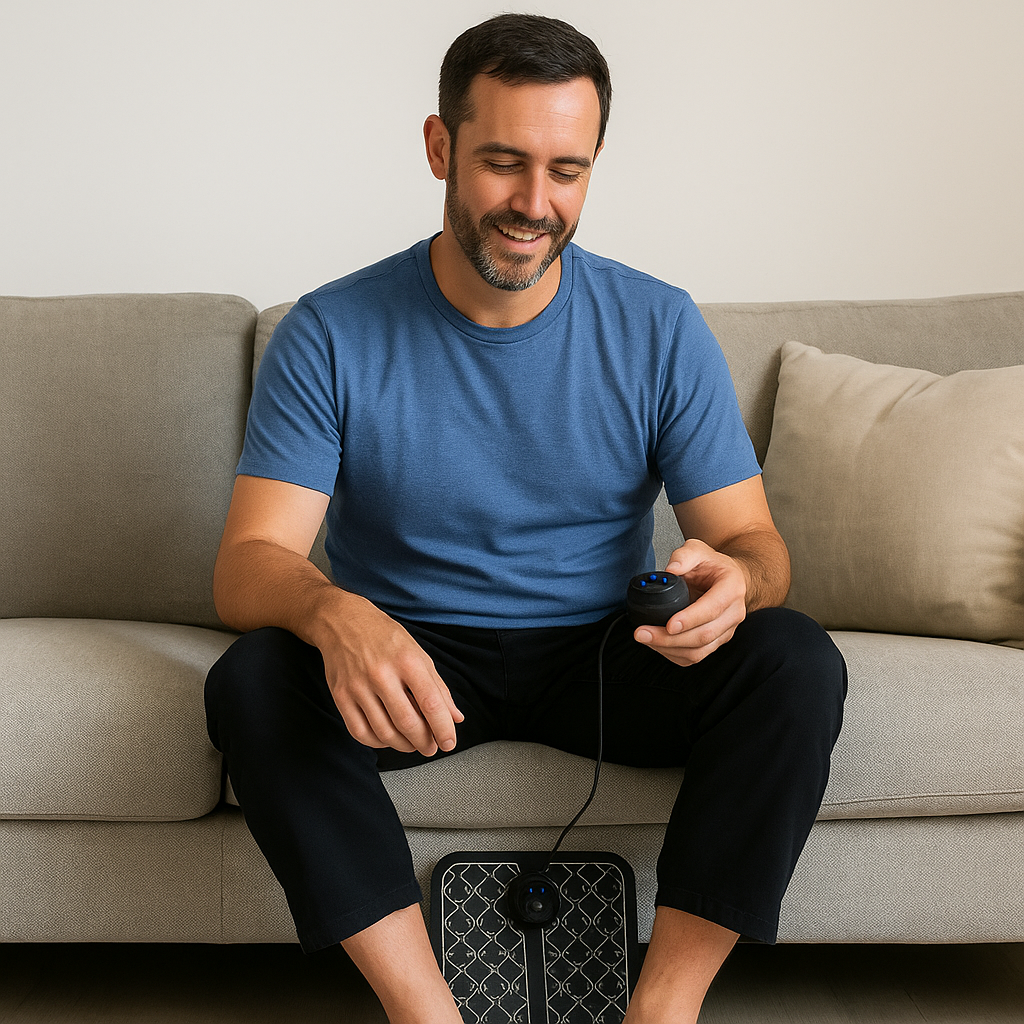Your feet carry you through every step of the day yet they often receive the least care and attention. From poor circulation to muscle fatigue, many people experience daily discomfort that can affect mobility and overall well-being. That’s where EMS (Electrical Muscle Stimulation) comes in.
But what exactly does EMS do for your feet, and how can this technology help improve their health and comfort? In this article, we’ll explore how EMS works, what benefits it offers, and why it’s becoming a popular solution for those looking to relieve tension, boost blood flow, and keep their feet feeling energised.
What are the benefits of EMS for your feet?
Electrical Muscle Stimulation (EMS) has become an increasingly popular method for improving foot health, especially for those suffering from pain, fatigue, or poor circulation. By sending gentle electrical impulses through the soles of your feet, EMS helps activate muscles, stimulate nerves, and promote better blood flow all without physical effort. Whether you’re on your feet all day or spend most of your time sitting, EMS can offer a wide range of benefits to keep your feet healthy, strong, and relaxed.
Improves blood circulation
One of the primary benefits of EMS is its ability to enhance blood circulation in the feet and lower legs. The electrical impulses cause small muscle contractions that mimic natural movement, helping the veins pump blood back toward the heart.
Better circulation means that oxygen and nutrients are delivered more efficiently to the tissues, while toxins and waste products like lactic acid are flushed away. This can reduce symptoms such as cold feet, numbness, and swelling common signs of poor circulation.
For people with sedentary lifestyles, diabetes, or age-related vascular issues, using EMS regularly can help maintain healthy blood flow and reduce the risk of circulation-related discomfort.
Relieves muscle tension and pain
EMS also provides effective pain and tension relief for tired or overworked feet. The gentle electrical stimulation helps relax tight muscles and calm nerve activity, which reduces discomfort from conditions such as plantar fasciitis, neuropathy, or general muscle fatigue.
It works by activating sensory nerves that block pain signals from reaching the brain a process known as the “gate control theory” of pain management. This creates an almost instant sense of relief, similar to the soothing effect of a deep massage.
Regular use can also help prevent cramps, stiffness, and soreness after long days of walking, standing, or exercising.
Reduces swelling and fluid retention
Many people struggle with swelling (edema) in the feet and ankles, especially after prolonged sitting or standing. EMS helps reduce this by stimulating both muscular and lymphatic activity. The rhythmic contractions promote lymphatic drainage the body’s natural process of removing excess fluid and toxins from the tissues.
With consistent use, this can lead to visibly reduced puffiness and improved comfort. People who experience water retention due to poor circulation, pregnancy, or lifestyle habits often find EMS therapy particularly beneficial.
Supports muscle recovery and strength
EMS isn’t just for relaxation it’s also an excellent tool for muscle recovery and strengthening. By contracting and relaxing the muscles repeatedly, it encourages better muscle tone and helps maintain strength, especially in individuals who are less active or recovering from injury.
Athletes can use EMS to speed up recovery after training sessions, as it helps eliminate lactic acid and reduces post-exercise soreness. For older adults, it helps keep the foot and calf muscles engaged, improving stability and balance.
This type of stimulation also helps prevent muscle atrophy the weakening or shrinking of muscles caused by inactivity making it a valuable aid in physical therapy or rehabilitation.
Helps with neuropathy and nerve health
For individuals suffering from peripheral neuropathy, especially those with diabetes, EMS can help improve nerve function and reduce numbness or tingling sensations in the feet. The electrical impulses gently stimulate the nerve endings, enhancing their responsiveness and communication with the muscles.
Over time, this can help restore some sensation, making movement easier and more controlled. EMS also improves circulation in the nerve tissue, providing vital oxygen and nutrients to maintain nerve health.
Promotes relaxation and reduces stress
Beyond its physical benefits, EMS therapy provides profound relaxation and stress relief. The gentle, rhythmic stimulation activates the body’s parasympathetic nervous system the “rest and recover” mode which lowers stress hormones and promotes calmness.
After a long day, a 15–20 minute EMS session can ease mental fatigue, reduce anxiety, and prepare the body for restful sleep. The feet are rich in nerve endings that connect to the rest of the body, so relaxing them can positively affect overall mood and well-being.
Enhances daily comfort and mobility
When circulation improves, muscles relax, and swelling decreases, everyday activities naturally become easier. Walking, exercising, or even standing for long periods feels less strenuous. People who use EMS regularly often report feeling lighter, more energised, and less fatigued.
For those who struggle with stiffness or balance issues, EMS therapy helps maintain flexibility and mobility, making it easier to stay active and independent.
How often should you use EMS for your feet?
The frequency of EMS (Electrical Muscle Stimulation) sessions for your feet depends on your goals, comfort level, and overall health. While EMS is safe for regular use, finding the right balance ensures you gain all its benefits from improved circulation to pain relief without overstimulation.
For most users, the ideal frequency is 15 to 20 minutes per session, three to five times a week. This allows your muscles to adapt to the stimulation and promotes long-term results such as better blood flow, reduced swelling, and improved mobility.
If you’re new to EMS, start slowly. Begin with shorter sessions at a low intensity, two to three times per week. This helps your muscles and nerves adjust to the sensations without fatigue. Once your feet are accustomed to the stimulation, you can gradually increase the frequency or duration of each session.
For people managing chronic conditions like poor circulation, neuropathy, or persistent foot pain, using an EMS foot device daily may be beneficial. However, it’s important to stay within the recommended time frame and intensity settings to avoid overstimulation or soreness.
Here’s a simple breakdown of recommended use based on needs:
-
General wellness and relaxation:
3–4 sessions per week for 15–20 minutes helps reduce tension, improve comfort, and support healthy blood flow. -
Recovery or pain relief:
Daily use at moderate intensity can ease soreness and promote faster recovery after exercise or prolonged standing. -
Chronic circulation issues or swelling:
20 minutes per day at a comfortable intensity level helps maintain regular muscle contractions that assist blood and lymph flow.
It’s best to use EMS therapy when your feet are clean, dry, and relaxed for example, in the evening or after physical activity.
Ultimately, consistency is more important than duration. Regular EMS use keeps your muscles active, your circulation healthy, and your feet refreshed helping you feel more energised and comfortable every day.
Why it’s becoming a popular solution for feet?
In recent years, EMS (Electrical Muscle Stimulation) has gained widespread popularity as an innovative, non-invasive solution for foot health and recovery. As more people struggle with poor circulation, fatigue, and daily foot pain, EMS foot devices have emerged as an accessible, science-backed way to restore comfort and mobility all from home.
One of the main reasons for their growing popularity is convenience. Unlike traditional massages or physiotherapy sessions, EMS foot massagers can be used anytime, anywhere. They require no effort you simply sit down, place your feet on the device, and let the gentle electrical impulses do the work. This makes them ideal for people with busy lifestyles, limited mobility, or those who can’t access regular professional treatment.
Another factor is scientific credibility. EMS technology has long been used in medical and sports rehabilitation to improve circulation, strengthen muscles, and aid recovery. Today’s foot massagers adapt that same proven method for everyday users, helping them relieve pain, stimulate blood flow, and maintain active muscles without strain.
In a world where many people spend hours sitting at desks or standing on hard surfaces, EMS has become a modern remedy for sedentary fatigue and poor leg health. The rhythmic stimulation mimics the natural movement of walking, preventing stiffness, swelling, and cold feet problems that affect millions globally.
Users also appreciate the holistic benefits of EMS therapy. Beyond its physical effects, it promotes relaxation, reduces stress, and supports better sleep by calming the nervous system. Many find that a short daily session leaves their feet feeling lighter, warmer, and more energised improving not just comfort but overall well-being.
Lastly, EMS foot massagers offer long-term affordability. Instead of paying for repeated treatments, users can enjoy consistent relief at home for a fraction of the cost.
In short, EMS foot massagers are becoming popular because they combine science, simplicity, and effectiveness offering an easy way to keep feet healthy, relaxed, and revitalised every day.
FAQ What does EMS do for your feet?
What exactly does EMS do for your feet?
EMS, or Electrical Muscle Stimulation, sends gentle electrical impulses through the soles of your feet to make the muscles contract and relax. This process helps improve circulation, relieve tension, and strengthen muscles, supporting overall foot health and comfort.
Can EMS improve blood circulation in the feet?
Yes, EMS therapy significantly boosts blood and oxygen flow by stimulating the muscles, which mimics the movement that occurs during walking. This helps reduce swelling, cold feet, and the feeling of heaviness caused by poor circulation.
Is EMS good for foot pain or fatigue?
Absolutely. EMS helps relieve pain and stiffness by activating nerves that block pain signals and encourage muscle relaxation. It’s especially useful for people who suffer from plantar fasciitis, neuropathy, or general muscle soreness after long hours of standing or walking.
Can EMS help with swollen feet and ankles?
Yes, EMS can reduce swelling and fluid retention by stimulating lymphatic drainage the body’s natural way of eliminating toxins and excess fluid. This makes it an excellent option for people with tired, puffy, or swollen feet.
How often should I use EMS for my feet?
For best results, use your EMS foot massager for 15–20 minutes per session, about three to five times a week. Consistent use helps maintain good circulation, muscle tone, and relaxation.
Is EMS safe for everyone to use?
EMS is safe for most people, but it should be avoided by individuals with pacemakers, heart conditions, epilepsy, or during pregnancy. Always consult a healthcare professional before starting EMS therapy if you have a medical condition.



Do EMS foot massagers really work?
How many times a day can you use an EMS foot massager?